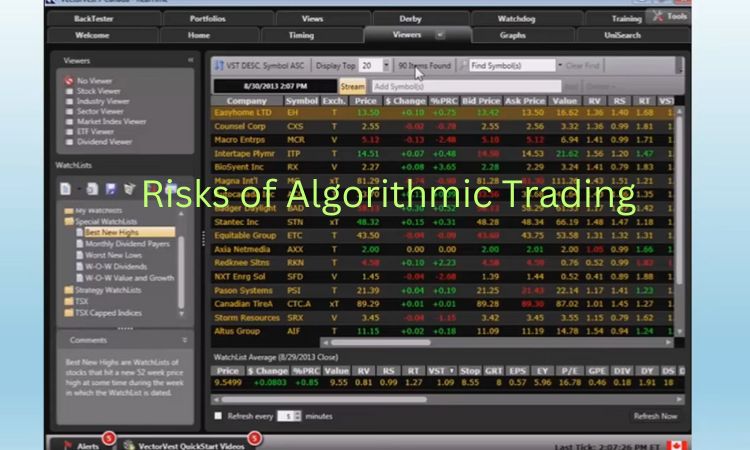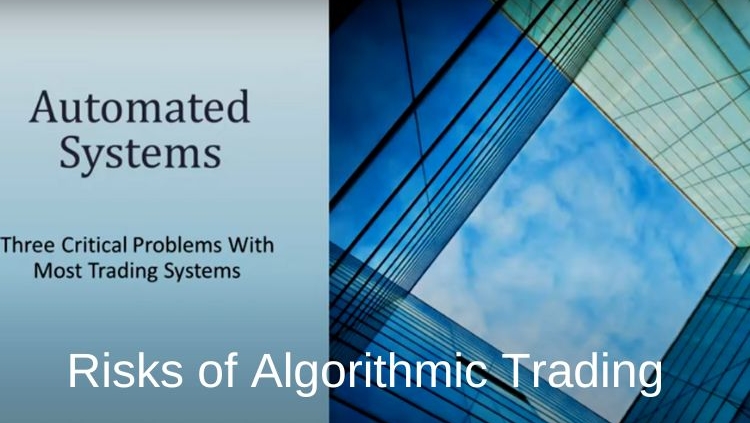Risks of Algorithmic Trading Systems: 3 Critical Problems
In recent decades, algorithmic trading has dominated the trading world. But this all has given a rise in the risks of algorithmic trading.
No doubt algorithmic trading and high-frequency trading nowadays have improved market liquidity with asset pricing consistency.
And apart from all that, the primary risk factor of algorithmic trading is amplifying systemic risks of algorithmic trading.

What Are The Risks Of Algorithmic Trading System?
Algorithmic and high-frequency trading is said to be profitable and trustworthy. Because of the minimal human involvement, it also decreases the risk of human errors.
But apart from that, many things increased the risks of algorithmic trading. Here is all the major risk given below:
Mechanical Failures:
The theory of automated trade is simple: you only have to set the software, program, and its rules and watch it do all your work. Automated trading is undoubtedly a sophisticated method of trading, but always remember it is still fallible.
There are chances that some trading system is on your computer but not on the software, which can cause a problem.
In easy words, it is possible that the order you were sending just because of a weak internet connection doesn’t reach its destination.
There can be a few other problems like power loss, system crash, or other issues in your system, causing problems in running the algorithmic system normally and creating risks of algorithmic trading.
Monitoring And Alerting System:
However, algorithmic trading is a system in which you can turn on your computer and leave it for days or weeks without monitoring. But it is also a big wrong step many investors do. Always remember that risks of algorithmic trading still requires monitoring or alerting system.
As for all the reasons mentioned above, like connectivity issues, system quirks, and many more, someone should monitor them so they can be solved without further delay.
Apart from that, there is also a chance of anomalies while algorithmic trading which can cause errant orders, missing orders, or even duplicate orders.
So that’s the reason why the system should be monitored so you can easily solve them as quickly as possible. And it increases the risks of algorithmic trading.
Trading Experience:
It is very important to have some trading experience in algorithmic trading so you can choose your complete trading strategy easily. If the trading strategy is highly complex with many variables, it becomes difficult to understand whether the trade is profitable.
So always try to choose simple automated trading strategies first; these will help you to develop experience and develop trading methods that will help you further in the future in many profitable traded.
Over-Optimization And Back testing:
Over optimization and back testing is another one in the list of risks of algorithmic trading. Many traders tend to follow back testing techniques and develop a system, but many create a system that looks good only on paper and in the live market, which is a complete disaster.
Generally, over-optimization is an excessive curve fitting which develops a trading plan, but these plans are unreliable while live trading in the market.
Example:
Here you have an example of risks of algorithmic trading, Suppose an investor edits a strategy plan to make it even more perfect for achieving exceptional results on historical data on which the strategy was tested.
But unfortunately, many traders assume that their strategic plan will be 100% beneficial and will never have any drawdown.
These types of strategies are created as the assumption of a near-perfect plan, but they always fail as soon as after reaching the live market.
Programming Discrepancies:
A sort of discrepancy is possible between different theoretical traders. These discrepancies are generated by order platform components and strategies and make them real trades.
While developing an automated trading system, many traders expect a learning curve. But starting with small sizes is a good idea because it gives you time while refining the process.
What Causes An Increase In The Disadvantages Of High-Frequency Trading?
1. Ripple effects:
Market and global economy asset classes have a rising degree of connectivity. The meltdown of the market or asset class causes a chain reaction that directly affects the market or asset class.
2. Increase in volatility:
In today’s market, there is a massive increase in high-frequency algorithmic trading activity. And some of the algorithmic systems are specially designed to outsmart competitors. In real time, you can see the reaction of algorithms to market conditions.
This may be because of an increase in the bid-ask by the algorithms during the volatile market, and creating risks of algorithmic trading. A similar rise in bid-ask can also see in different conditions like temporarily halting trading, increasing volatility, and reducing liquidity.
3. Unreliability:
A significant contributor to high-frequency trading is excessive market volatility. This can cause short-term concern for many traders and investors. Apart from that, it also impairs the confidence of traders or investors in the long run.
However, when the market crash unexpectedly, it is a real shock for traders who can’t stop thinking about this drastic effect.
Many different large traders allow their investors to lower the trading risk during a news Vacuum. This news Vacuum always occurs and puts extra pressure to cause a downward fall in the market.
4. Another Crucial Risk:
Many regulators, finance experts, and academics disagree with high-frequency trading, which is why it is still a controversial activity.
High-frequency trader rarely retains their portfolios at night. But yes, it is not obvious to always invest a small amount of money, hold it for a short period and then liquidate it.
This can increase the risk-reward ratio. As compared to traditional long-term investors, a risk-reward ratio is relatively high.
A high-frequency trader can only make a profit from a penny, and this penny can lead to gains throughout the day. And then, with the increased risks of algorithmic trading considerable loss also increases.
5. Investors’ Huge losses:
Those volatility fluctuations exacerbated by algorithmic high-frequency trading can cause a huge amount of loss for investors.
There is also an option for stop-loss orders, which investors use when their current price exceeds 5%. If the market gap suddenly falls without any reason, these stop losses will be initiated automatically.
FAQs
What is the risk of algorithmic trading?
There are different risks of algorithmic trading systems, but the main one is problems in IT systems and processes. We all know that computers control algorithmic trading, so any technology error can cause big trouble.
What is the biggest risk of algorithmic trading?
The most significant risk of algorithmic trading is amplifying systemic risk. It has a different way of growing on the market volatility and spreading in the other market. Regularly unusual market volatility can erode the faith of many investors in the market’s integrity.
Is algorithmic trading completely free from risk?
Different trading platforms are completely unregulated. This causes zero chances of recourse in case of miss-selling. Or the same in the case of manipulation caused by algo traders.
Conclusion
The most significant risks of algorithmic trading or high-frequency trading system is that it can amplify systemic risk.
It has the propensity for growing market volatility to spread into the other market. And this can cause investor anxiety. So with all the risks mentioned above, make sure to read them carefully. Apart from that, before investing, do proper research first.


